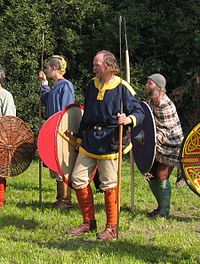Ango
| Ango | |
|---|---|

|
|
| Information | |
| Weapon type: | spear |
| Use: | War weapon, hunting weapon |
| Creation time: | approx. 480 AD |
| Working time: | approx. 480 AD – 520 AD |
| Region of origin / author: |
Franconian Empire , Frankish tribes |
| Distribution: | Franconian Empire , Lower Rhine area |
| Overall length: | approx. 200 cm - 300 cm |
| Blade length: | approx. 10 cm |
| Handle: | Wood, leather |
| Lists on the subject | |
The Ango ( Middle Greek ἄγγων angōn , Old High German ango "hook, sting, point") is a form of spear with an approximately ten centimeter long, arrow-shaped blade made of iron , barbs and a square cross-section on an extremely long spout about one meter in length. The spout was connected to a wooden shaft. The total length of this weapon was probably between two and three meters. The ango was used as a combat and hunting weapon .
It was also used to pierce the opponent's shield and, if possible, this himself. After piercing the shield, it should be snatched from the enemy with the help of the barbs and the weight of the Angos. The thin front part, like that of the Roman pilum , was constructed in such a way that it bent after the throw and thus became unusable for the opponent.
The ango was mainly found among the Franks , but was also found among other tribes such as the Thuringians . The Ango was most widespread in the sub-Rhine area, which is enclosed by today's cities of Lille , Bielefeld and Karlsruhe . Most of the finds could be dated to the years 480 to 520 AD.
Sometimes the ango is also called a Franconian hook .
Description at Agathias
The following is what Agathias reports in his histories about the arming of the Franks:
- “These angons are medium-sized spears, suitable for hurling and thrusting in close combat. The iron fitting covers the largest part, so that the wood can hardly be seen at the bottom; At the top of the point there are some curved points, in the shape of fishhooks, curved downwards on both sides. In battle, the Franconian throws such an Angon. When it hits the human body, of course, the point penetrates, and it is difficult for a person who has been hit as well as for another to pull the projectile out, because the barbs stuck in the flesh offer resistance and increase the pain, so that the enemy, even if the wound was not fatal in and of itself, it must perish. If, on the other hand, the shield is hit, the spear hangs down from it and moves at the same time, and the lowest end drags on the ground. The person concerned cannot pull out the spear because of the hooks that have penetrated and cannot cut off because the wood is protected by the iron that has been folded over. If the Franconian sees this, he quickly jumps on it and steps on the lance shaft, so that the shield is pressed down, the owner's hand has to give way and head and chest are exposed. Then it is easy to kill the uncovered opponent, either with an ax blow on the head or with a thrust with a second spear in the throat. Such is the armament of the Franks, and this is how they prepared themselves for battle. "
See also
literature
- Siegmar von Schnurbein : To the ango. In: Georg Kossack , Günter Ulbert (Hrsg.): Studies on prehistoric and early historical archeology. Festschrift for Joachim Werner on his 65th birthday. Volume 2: Early Middle Ages. Beck, Munich 1974, ISBN 3-406-00344-3 , pp. 411-434 ( Munich contributions to prehistory and early history, supplementary volume 1, 2).
- Richard Underwood: Anglo-Saxon weapons and warfare. Tempus, Stroud 2001, ISBN 0-7524-1910-2 (English).
Individual evidence
- ↑ Felix Mundt: Beatus Rhenanus: Rerum Germanicarum libri tres (1531): edition, translation, studies , volume 127 of early modern times, Verlag Walter de Gruyter , 2008, ISBN 3484970758 , page 245 [1]
- ↑ Agathias, Historien II 5, trans. by David Coste , Leipzig 3 1922.